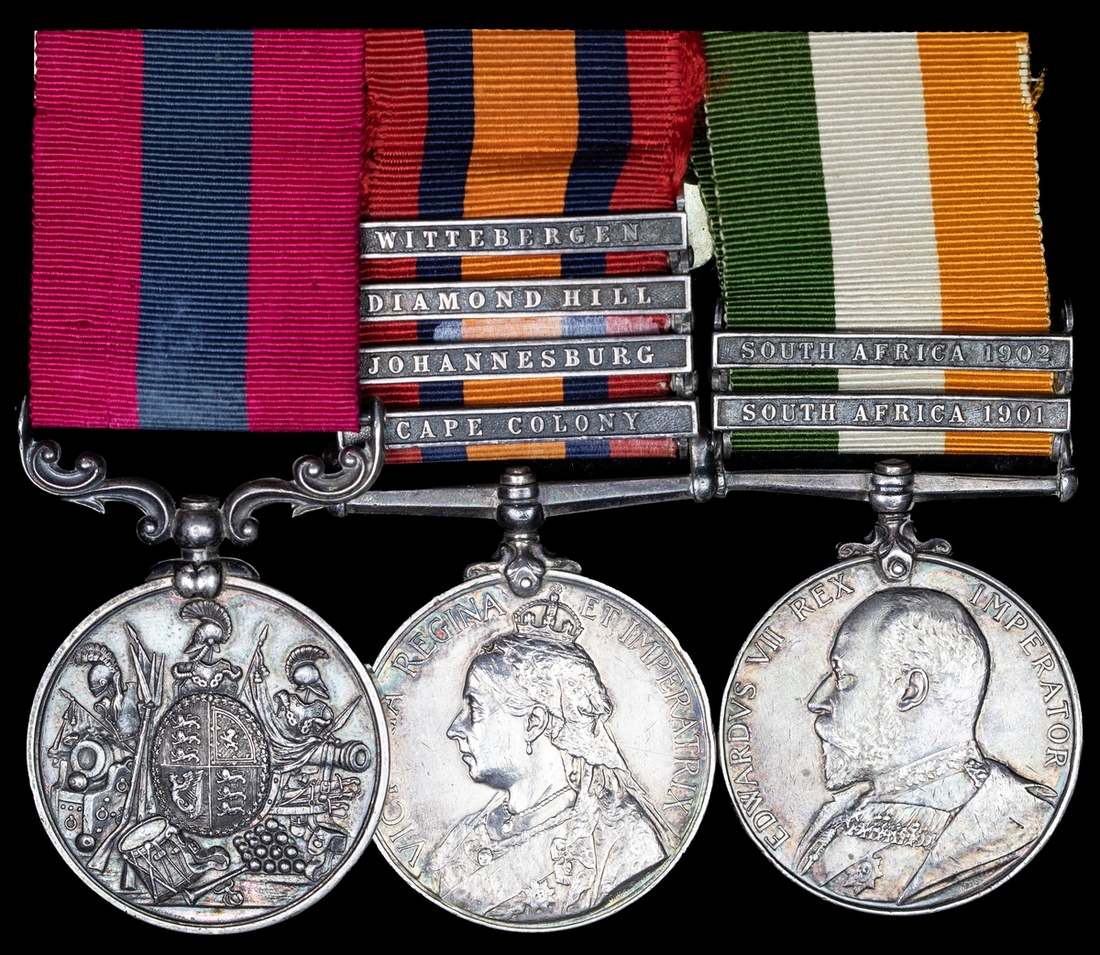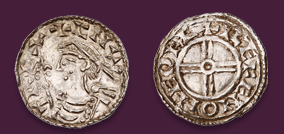
Auction: 25003 - Orders, Decorations and Medals
Lot: 200
A Boer War D.C.M. group of three awarded to Colour Sergeant H. Snaith, Royal Sussex Regiment who was also 'mentioned' for his service in the war
Distinguished Conduct Medal, V.R. (2055 Serjt: H. Snaith. Rl: Sussex Regt); Queen's South Africa 1899-1902, 4 clasps, Cape Colony, Johannesburg, Diamond Hill, Wittebergen (2055 Sgt H. Snaith. 1st Rl. Sussex Regt); King's South Africa 1901-02, 2 clasps, South Africa 1901, South Africa 1902 (2055 Clr: Serjt: H. Snaith. Rl: Sussex Regt), mounted as worn, light contact marks very fine (3)
D.C.M. London Gazette 27 September 1901.
M.I.D. London Gazette 10 September 1901.
Henry Snaith was born in the parish of All Saints, Hastings, Sussex, and having worked as a labourer, enlisted into the army at Hastings on 12 October 1885, joining as a Private (No.2055) into the Royal Sussex Regiment. Posted to the 1st Battalion, he was appointed to Lance Corporal on 9 September 1886, and promoted to Corporal on 27 March 1888, before being appointed to Lance Sergeant on 16th December 1889, and promoted to Sergeant on 19 December 1890, and to Colour Sergeant on 15 May 1892.
Snaith reverted to Sergeant at his own request on 1 February 1894, but was then tried by District Court Martial for embezzlement on 31 March 1896, found guilty and sentenced to be reduced to Corporal. Having re-engaged at Brighton on 7 October 1897, he was once again appointed to Lance Sergeant on 19 October 1897, and promoted to Sergeant on 19 September 1899 before being posted to the Depot on 18 October 1899.
Having so far seen home service, Snaith was then posted back to the 1st Battalion on 16 December 1899 on which date he was posted to Malta, and with the Boer War having just broken out, he then found himself posted to South Africa on 21 February 1900. The 1st Battalion disembarked at the Cape about 20 March 1900. Along with the 1st Derbyshire, 1st Cameron Highlanders, and the City Imperial Volunteers, they formed the 21st Brigade, which was created after the occupation of Bloemfontein, the brigadier being Bruce Hamilton, who at the commencement of the war was a major in the East Yorkshire Regiment, and had been in Natal as AAG in General Clery's division. The brigade was certainly most fortunate in its commander, although it was a surprise to many to see one so young get the post. That the selection was right was proved, for no man in the whole campaign did more consistently brilliant work. His record is faultless. He was equally successful as an infantry brigadier and as commander of a number of mobile columns harassing the enemy and capturing laager after laager in the Eastern Transvaal, where he was so long pitted against Louis Botha.
The 21st Brigade was ordered to join Ian Hamilton, who was to command the army of the left flank in the northern advance, and linked up with his force on 2 May 1900.
Snaith as such then saw service on operations in the Cape Colony, and his battalion was first in action at the battle of Doornkop or Florida on 29 May, when 5 men were killed and 15 wounded. Snaith was then present at Johannesburg on 31 May 1900, and after the capture of Pretoria Ian Hamilton's Infantry Division was broken up, Smith-Dorrien's brigade being needed on the line between Kroonstad and the capital; the 21st Brigade, however, remained under the two Hamiltons, and at Diamond Hill had the most prolonged fighting they had seen. The successes of De Wet and the Free State Boers against the lines of communication had encouraged the Transvaalers to close in on the east of Pretoria, and it became necessary to drive them off.
Snaith was in action at Diamond Hill on 11-12 June 1900. On 11 June the position roughly was—French with two Cavalry Brigades, or what was left of them, was on the left; Pole-Carew with the Guards and Stephenson's 18th Brigade in the centre and left centre; the 21st Brigade on the right centre; and Broadwood's and Gordon's cavalry brigades on the right. The position could not be turned, and the mounted men could no more than hold their ground. Mr Churchill in his excellent account of the battle says: "Ian Hamilton directed Bruce Hamilton to advance with the 21st Brigade. This officer, bold both as a man and as a general, immediately set his battalions in motion. The enemy occupied a long scrub-covered rocky ridge below the main line of hills, and were in considerable force. Both batteries of artillery and the two 5-inch guns came into action about two o'clock. The Sussex Regiment, moving forward, established themselves on the northern end of the ridge, which was well prepared by shelling; and while the City Imperial Volunteers and some parts of the mounted Infantry, including the corps of guides, held them in front, gradually pressed them out of it by rolling up their right. There is no doubt that our infantry have profited by the lessons of this war. The widely extended lines of skirmishers moving forward, almost invisible against the brown grass of the plain, and taking advantage of every scrap of cover, presented no target to the Boer fire. And once they had gained the right of the ridge it was very difficult for the enemy to remain. Accordingly at 3.30 the Boers in twenties and thirties began to abandon their position. Before they could reach the main hill, however, they had to cross a patch of open ground, and in so doing they were exposed to a heavy rifle-fire at 1200 yards from the troops who were holding the front".
On the 12 June the action was renewed, the Guards supporting the 21st Brigade. The Derbyshire advanced on the right, the City Imperial Volunteers in the centre, and the Sussex on the left. Progress was slow, as the enemy's position was very strong, but the 82nd Battery, having been hauled on to the plateau where our troops were lying in extended order, by its splendid devotion maintained the ground won, beat down the Boer fire, and saved a withdrawal; but, as usual when a regiment or battery does a fine feat, the toll had to be paid. Mr Churchill says: "But the battery which had reduced the fire, by keeping the enemy's heads down, drew most of what was left on themselves. Ten horses were shot in the moment of unlimbering, and during the two hours they remained in action, in spite of the protection afforded by the guns and waggons, a quarter of the gunners were hit. Nevertheless the remainder continued to serve their pieces with machine-like precision, and displayed a composure and devotion which won them the unstinted admiration of all who saw the action". In the afternoon two other batteries and more troops were pushed to the front, and that part of the position was carried. During the night the enemy withdrew entirely. All accounts of the battle praise unstintingly the work of the 21st Brigade. Lord Roberts says: "The troops advanced under artillery fire from both flanks, as well as heavy infantry fire from the hill itself. The steadiness with which the long lines moved forward, neither faltering nor hurrying, although dust from bullets and smoke from bursting shells hung thick about them, satisfied me that nothing could withstand their assault. The position was carried at 2 pm ... Fighting continued till dusk, the Boers having rapidly taken up a fresh position near the railway".
No sooner was Diamond Hill over than Ian Hamilton, with, among other troops, the 21st Brigade, was despatched to the north-east of the Free State against the Boers there who were damaging the lines of communications. The general met with an accident near Heidelberg, breaking his collar-bone, and his place was taken by Sir A Hunter.
Snaith then found himself present in the operations at Wittebergen which lasted from 1-29 July 1900. About 8 July Reitz was reached, where the 21st Brigade were to remain a few days. Thereafter a series of rather complicated movements (detailed in Sir A Hunter's despatch of 4 August 1900) took place, with the object of getting possession of the doors leading into the Brandwater basin and locking the enemy in. On the 16 July the Sussex occupied Meyer's Kop, ten miles west of Bethlehem. On the 20 and 21 Bruce Hamilton had the Camerons heavily engaged at Spitz Kop, but the position was gained. On the 23 July the Sussex had a task which was found rather too heavy, but with the assistance of other troops the objective was gained next day. For some days further Bruce Hamilton had fighting, marching, and stiff hill-climbing, but the result of the operations was worthy of the loss and labour, 1300 of the enemy surrendering on the 30th to Bruce Hamilton, and a large number to other generals,— about 4000 in all.
After 31 July the doings of the brigade are not easily followed. It may be said to have been broken up, although General Bruce Hamilton had the Sussex and Camerons, along with the 2nd Bedfordshire and other troops, in a column which operated in the Kroonstad district during the autumn of 1900. Snaith was promoted to Colour Sergeant on 20 October 1900.
Twelve officers and 16 non-commissioned officers and men were mentioned in Lord Roberts' final despatch as published in the London Gazette for 10 September 1901, one of those being Sergeant Snaith, and he was subsequently awarded the Distinguished Conduct Medal, the award being published in the London Gazette for 27 September 1901.
By early 1901 Colonel du Moulin was put in command of a small column, including his own battalion. During the remainder of the campaign this column operated in the Orange River Colony, chiefly to the west of the Bloemfontein railway. On 28 January 1902 the column was bivouacked behind a small kopje on the south of the Riet, near Abraham's Kraal. At 1 am the picquet holding the kopje was rushed. Colonel du Moulin as he hurried out to repel the enemy was killed, but Major Gilbert taking command, the kopje was recaptured and successfully held against a second attack. The Sussex lost, in addition to their colonel, 10 men killed and 6 wounded. Speaking of the colonel's death, Lord Kitchener used the words, "Whose loss to the army as a leader of promise I greatly deplore". At one period of the war, when mounted men were much in demand, the colonel of the Sussex got his whole battalion on horseback. Snaith is shown as having gained his Mounted Infantry Certificate, which was eventually awarded to him on 9 September 1903.
With the end of the war, Snaith was posted home with his battalion on 5th June 1902, and then back to Malta on 2nd December 1904, before being posted to Crete on 29th May 1905 as part of the international response to the Theriso revolt. Snaith was posted home again on 14th March 1906 and discharged on 11th October 1906.
With the outbreak of the Great War, Snaith was living in Ireland at Lisnagen, Rathcormic, Country Cork, and he then attested as a Private (No.T.R/10/8072) with the Royal Sussex Regiment at Fermoy on 2 October 1914, being immediately re-instated as an Acting Colour Sergeant and posted to the 10th Reserve Battalion in that rank on 31 October 1914. The battalion was then stationed at Dover. Appointed an Acting Company Sergeant Major on joining the battalion, he was promoted to Warrant Officer 1st Class and Regimental Sergeant Major on 21 January 1915 and then having moved with the battalion to Colchester in April 1915, on it being retitled as the 23rd Training Reserve Battalion in September 1916, he continued as the Regimental Sergeant Major. He is believed to have been discharged in November 1916, and having seen home service, is not entitled to any further awards.
Sold with copied research and an original Military History Sheet covering his Great War service.
Subject to 20% VAT on Buyer’s Premium. For more information please view Terms and Conditions for Buyers.
Estimate
£1,400 to £1,800
Starting price
£1100




